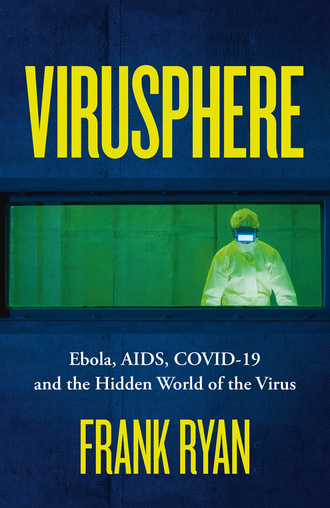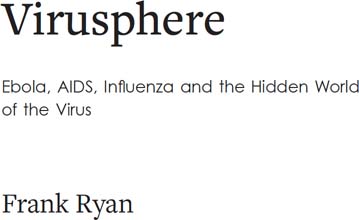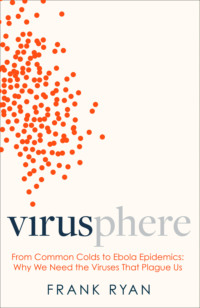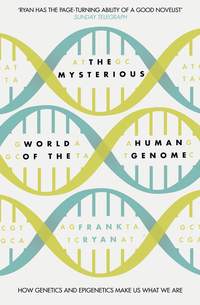
Полная версия
Virusphere



Copyright
William Collins
An imprint of HarperCollinsPublishers
1 London Bridge Street
London SE1 9GF
WilliamCollinsBooks.com
This eBook first published in Great Britain by William Collins in 2019
Copyright © Frank Ryan 2019
Cover photograph © Jacobs Stock Photography Ltd/Getty Images
Frank Ryan asserts the moral right to be identified as the author of this work.
A catalogue record for this book is available from the British Library.
All rights reserved under International and Pan-American Copyright Conventions. By payment of the required fees, you have been granted the non-exclusive, non-transferable right to access and read the text of this e-book on-screen. No part of this text may be reproduced, transmitted, down-loaded, decompiled, reverse engineered, or stored in or introduced into any information storage and retrieval system, in any form or by any means, whether electronic or mechanical, now known or hereinafter invented, without the express written permission of HarperCollins.
Source ISBN: 9780008296674
eBook Edition © March 2019 ISBN: 9780008296698
Version: 2020-02-28
Dedication
I would like to thank my editors,
Myles Archibald and Hazel Eriksson,
and my agent, Jonathan Pegg,
for their support of my writing this book
Epigraph
We all play hideous games with each other.
We step inside each other’s chalk circles.
Anthony Hopkins
Contents
Cover
Title Page
Copyright
Dedication
Epigraph
Introduction
1. What Are Viruses?
2. Coughs and Sneezes Spread Diseases
3. A Plague Upon a Plague
4. Every Parent’s Nightmare
5. A Bug Versus a Virus
6. A Coincidental Paralysis
7. Deadly Viruses
8. An All-American Plague
9. Lurker Viruses
10. How Flu Viruses Reinvent Themselves
11. A Lesson from a Machiavellian Virus
12. The Mystery of Ebola
13. The Mercurial Nature of the Zika Virus
14. A Taste for the Liver
15. Warts and All
16. Lilliputian Giants
17. Are Viruses Alive?
18. Inspiring Terror – and Delight
19. The Ecology of the Oceans
20. The Virosphere
21. The Origins of the Placental Mammals
22. Viruses in the Origins of Life
23. The Fourth Domain?
Bibliography and References
Index
About the Book
About the Author
Also by Frank Ryan
About the Publisher
Introduction
What springs to your mind when you sit back and consider viruses? I am altogether aware that even if you come, as will many of my readers, from a non-scientific background, you will likely be uncertain as to the strange and ill-definable nature of viruses. Even among scientists, viruses are among the most enigmatic of the biological entities that are to be found on our precious blue-girdled planet. Certainly, there is a good deal of misinformation about them. You might, for example, be apt to confuse them with bacteria, a confusion that is not helped by the fact that we doctors caused this confusion in the first case by lumping two radically different entities together as the ‘microbes’ that are the root cause of infectious diseases.
Viruses frighten us. They elicit a primal fear of the unknown. They are capable of crashing through our natural barriers and defences, turning healthy cells into microscopic factories to produce exponential numbers of daughter viruses. These swarm through the bloodstream, drawing the attention of the immune system. This provokes our own white blood cells and other immune defences to become an aggressive reactionary force, fixated on annihilating the invaders, regardless of the devastation in their wake – indeed our very own immune system contributes to many of the familiar symptoms of the resultant illness, from runny noses to violent, bloody haemorrhages. In effect, every infection becomes a pitched battle that will determine the outcome for us, the host. As we come to know viruses better, we discover that they have also come to know us intimately, taking advantage of our very behaviour to facilitate their infectiousness and spread among us. All in all, that is rather scary. Especially so when we consider that some of those viruses include some of the most dangerous entities on the planet, entities eminently capable of making us very sick indeed – even killing us.
It is hardly surprising that we should fear them and consider them an epitome of menace, perhaps even evil. But contrary to what we might think about viruses, they are not driven by malice. Their ultimate goal, just like that of all living organisms, is simply to survive and multiply, thereby ensuring the success of their kind. That’s all very nice to know but this lack of malice is hardly a comfort to us when we are infected by a virus. It is only natural in such circumstances that we might resent viruses and what they might do to us. It is equally natural that we should also feel the need to protect those we love from viruses while knowing that, if and when one of them comes along, it will arrive among us, unseen and unknowable, causing damage and pain among us, even to the most innocent, without feeling or rational explanation.
We are comforted by the knowledge that there are vaccinations available to protect us and our families from these viruses. But that same misinformation about various different vaccination campaigns has sown confusion among us. Meanwhile, there appears to be little to nothing that we can do about certain epidemic varieties, such as the norovirus or the common cold, which sweep through our populations as common experiences, albeit experiences we would rather avoid, provoking altogether negative associations in relation to viruses. Is it any surprise that we are inclined to wonder what other capacity for mischief viruses are capable of? You might well take the question further and wonder aloud: what is the purpose of these minuscule entities? Wouldn’t our world be a good deal better off if these dratted parasites were simply eliminated from the scene, never to bother us any more?
The curious thing is that, while as a doctor I sympathise with such sentiments, I cannot entirely agree with them. Counter-intuitive as it might seem, I know that a world without viruses would not be one in which I would care to live. Why do I suggest such a thing? It introduces what might appear to be a contradictory question. Does the existence of viruses really matter to you and to me? I can assure my readers that, contrary to what our primal instincts might suggest, the answer is, strangely, but indubitably, yes!
In his elegant essay ‘The Lives of a Cell’, the late Lewis Thomas drew attention to the fact that we humans are not above the rest of life. In his words, ‘Man is embedded in nature.’ While accepting the fundamental truth in this, I would further extrapolate from it the fact that nature is embedded in humankind. And the nature I am referring to includes viruses. I don’t, however, expect you, my readers, to simply take my word on this. But even the possibility that we humans owe our existence to, and remain dependent on, the very existence of viruses is more than enough to suggest we take the trouble to understand them.
That is what I hope to achieve in writing this book. It is my intention to enable you, my readers, to understand viruses.
In fact, even at a self-interest level, it is only natural that we should feel the need to understand entities that are capable of seriously hurting us. We surely need to know how they might threaten us and our loved ones and what we can possibly do to mitigate this threat. I freely confess that this was my perspective when, as a youthful medical student, I performed my first experiments on viruses long ago. Years later it remained my perspective when, as a busy hospital physician dealing with serious medical emergencies, it was my duty to diagnose and treat many patients suffering from viral infections. But then, during a period of international travel aimed at examining what was actually happening when new ‘emerging viruses’ were threatening entire populations, I discovered that my former perspective was somewhat blinkered in relation to viruses. Here I invite my readers to remove those same blinkers and look beyond the undoubted mischief of viruses to find answers to their behaviour and presence among us.
Key to such understanding is to get to know their strange and extraordinary world. Thanks to the most modern advances in the science of virology, we are now in a better position than ever before to understand that world. We are about to explore what, in scientific circles, is now called ‘the virosphere’, a play on which forms the title of this book.
How could such an exploration be anything other than an odyssey? Viruses circumambulate our world with the speed of a passenger jet, paying no heed to national boundaries, or circumscribing notions of nationality, ethnicity, race or religion. They pay no heed to sex or age, or social class, or indeed any human hubris of fame, celebrity, wealth or power. They are devoid of any sense of justice or morality, so that our social or religiously derived morals prompting concepts of goodness, badness, justice, sin, simply do not apply. Now add to this situation the fact that these threatening entities are, for the most part, utterly invisible, even under the most powerful magnification of the light microscope, making them all the more enigmatic – and perhaps also the more scary. These invisible entities invade not just our tissues and organs, but, to borrow the metaphor from Anthony Hopkins, they step inside the chalk circles of our most intimate and innermost being: the nucleus of our living cells, the repository of our coding DNA.
It is not a bad thing that we should be wary of viruses, but in this exploration we need to rise above mere scare stories. The fact is that the vast majority of viruses in this world – and there really are very many of them – have no mischievous interest in humans. This rather begs a new question: if such viruses are not interested in you and me, what are they interested in?
My purpose in writing this book is to explain what viruses really are, to accurately define them, and from such an understanding to explore their role in our human history and the wider history of our world. I hope to do so in a way that readers, whether they come from a scientific background or have no prior knowledge of viruses, will understand the true importance of viruses to life and to the biosphere. Given such potential importance, how can we possibly get to grips with such minuscule entities? How can we even hope to visualise their quintessentially viral way of life in their complex ultramicroscopic world? As with historic explorations of alien worlds, it might help our exploration if we could avail ourselves of some guide.
I would suggest that there is an obvious guide, one that is entirely apposite, whose perspective has only recently been opened up to us in wonderful detail through the deepest penetration of the living world by the enlightenment of modern scientific techniques. In this new age of ultramicroscopic exploration, we shall be getting up close and personal to the viruses themselves. As we shall discover, viruses really are far more embedded in us, and in the biological and ecological world that we inhabit, than most ordinary folk might possibly imagine.
I
What Are Viruses?
Only in the last decade have we come to realise that, from its very beginnings, all of cellular life has inhabited not only the visible biosphere – of solid earth, air and oceans – but also a less familiar and invisible virosphere. The viruses that constitute this virosphere are not merely surrounding us, they are within us, both as evolving extrinsic organisms in themselves and as interactive symbiotic entities that are an intrinsic part of our being. We might not be aware of the presence of these minuscule passengers within us from moment to moment, but the passengers are, in their quintessentially viral way, aware of us.
This might seem somewhat daunting, even frightening, to some of us, but there is no need for alarm. They have always been there. It is likely that they preceded any origins of human life on planet Earth, or indeed, going further back, the origins of the mammals, or any animals or plants, or fungi, or, if I am right, even the single-celled amoebae. All that has changed is that the world of virology is coming to understand the role of viruses in the origins and diversity of life, and what might appear incongruous to any notion of viruses being exclusively agents of disease, the health of the biosphere.
For viruses to achieve all this they must surely possess some remarkable properties. For example, they have no means of locomotion yet they move among us: in pandemic forms they effortlessly circulate around the globe. Although they have no sense of vision, hearing, touch, smell or taste, they detect with uncanny precision the cell, or organ or tissue that is their target destination. This they achieve despite the relentless opposition of powerful immune defences designed to prevent this happening; and once arrived, they penetrate the defences of the target cell, break entry through its protective surface membrane, and once inside take over its physiological, biochemical and genetic programming to compel the cell to become a factory for the production of a new generation of themselves.
Welcome to the world of viruses!
It is, admittedly, a very strange world replete with mysteries. It becomes all the more quixotic when we attempt to examine it at the most basic level.
What then are viruses? How do we even begin to define them? What, for instance, is the difference between, say, a bacterium and a virus? While viruses and bacteria are often confused in the minds of ordinary folk, because they cause many of the common infectious diseases, bacteria and viruses are very different entities. Viruses are more difficult to define than bacteria because they are said to occupy a position somewhere between the biological notions of life and non-living chemicals. This has tempted a distinguished colleague to dismiss them as ‘a piece of mischief wrapped up in a protein’. While the hubris contains a grain of truth, there is rather more to viruses than being merely a source of mischief. So let us delve a little deeper! Do viruses rely on genes, and genomes, like all of the more familiar forms of life, from whales to humans and buttercups to the so-called ‘humble’ bacterium? The answer to that question is, ‘Yes!’ Viruses do indeed have genomes, which contain protein-coding genes. We shall discover more about those viral genomes in subsequent chapters when we shall also observe some important differences between the genomes of viruses and all other organisms.
Do viruses follow the same patterns of evolution as, say, plants and animals? The answer again is, ‘Yes!’ But the patterns of evolution – the specific mechanisms involved – are heavily influenced by a facet of their organismal existence that is confined to viruses. Viruses can only replicate by making use of the host cell’s genetic apparatus, and because of this, viruses were formerly defined as ‘obligate genetic parasites’. But with our increasing understanding of viruses, and of their complex roles in relation to the evolution of their hosts, this definition is no longer sufficient to characterise them. A more adequate definition must take on board the fact that viruses are symbionts. Indeed, we now know that viruses are the ultimate symbionts, exhibiting many examples of all three patterns of symbiotic behaviour, namely parasitism, commensalism and mutualism. Moreover, since viruses will sometimes employ aggression as an evolutionary pattern of behaviour in relation to their hosts, they are also potentially ‘aggressive symbionts’.
The more we examine viruses, in their evolutionary trajectories and in the influence of that trajectory on the evolution of their hosts, the stranger and more fascinating their story becomes. Is it reasonable to propose that viruses were born at the stage of chemical self-replicators before the actual advent of cellular life on Earth? If so, how then, from those primal beginnings, did viruses evolve, to interact with, and thus contribute to, the evolution of all of life on this planet?
The aim of this book will be to enlighten readers through a step-wise progression, starting with a familiar territory: we shall confront the wide range of illnesses that are caused by viruses. For example, we shall examine what is really going on in the common cold, the childhood illnesses such as measles, chickenpox, herpes and mumps, rubella, as well as less familiar examples such as rabies, ‘breakbone fever’, haemorrhagic fevers such as Ebola, and virus-induced cancers such as Burkitt’s lymphoma. In such an examination we shall discover what makes viruses tick, exploring what’s actually going on inside us when we encounter the virus, how this gives rise to the symptoms we get from the infection, and, key to deeper understanding, probing what the virus itself gets from the ‘interaction’ with its human host. We shall employ the same virus-orientated perspective to explore important epidemic forms such as influenza, smallpox, AIDS and polio, which will illustrate how viral infections have impacted on human social history, from the wall paintings of the Ancient Egyptians to the colonisations of the Americas, Australasia and Africa. We shall also take a close look at vaccines as a measure to prevent epidemic infections, from the first introduction of vaccination against smallpox centuries ago to the recent controversy concerning the triple vaccine and the papilloma virus vaccine.
The science of virology grew out of the study of viruses in the causation of disease. Through understanding the viruses already familiar to us, we shall widen our enlightenment by examining the role of viruses in the evolution of life, and in particular we shall explore the role of viruses in our human evolutionary history. We shall see how, throughout our prior evolution, we have shared our existence with these powerful invisible entities, and how they really have changed us at the most intimate level, to help make us human.
I hope that, like me, you will come to appreciate the enormous importance of viruses to life, in its origins and complexity, while also marvelling at the existential nature of what is one of the great wonders of life on our beautiful blue-oceanic planet. Viruses, by and large, have had a bad press. This is understandable, given the experiences of earlier generations of virologists, whose only contact with viruses was in dealing with the infections caused by them. But today a major wind of change is blowing through the world of virology – so much so that recently a distinguished evolutionary virologist declared that we were witnessing what he called ‘The Great Virus Comeback’. What does he mean by this? Why have some of the modern pioneers of virology introduced the term ‘virosphere’ as the key to a new exploration of the importance of viruses to the entire biosphere? Could it be true that, as some would have us believe, viruses should now be seen as the ‘Fourth Domain of Life’?
2
Coughs and Sneezes Spread Diseases
Historically, viruses were included with the so-called ‘microbes’ – tiny organisms that were originally discovered as the cause of infectious diseases in humans, animals and plants. Interestingly, there is a part of us that has long been intimately acquainted with microbes in general, and with viruses in particular. This is our inbuilt system of defences against infection: what doctors refer to as our immune system. It is perhaps as well that we possess this inbuilt immunological protection, because we inhabit a world that teems with microbes.
A veritable zoo of such microbes covers our skin and other surface membranes. Biologists call this the ‘human microbiome’. Although it might cause some of us to squirm a little just to acknowledge its existence, this secret world is no real threat to us. It is an intrinsic part of our being, comprising a variety of bacteria, as well as other microbial forms, that inhabit our surface skin, mouth and throat, nostrils and nasal cavities, and in the case of women, the genital passages. Our bodies are said to contain roughly 30 to 40 trillion cells – if you are mathematically inclined, this is 3 to 4 times 1013 – which comprises the sum total of living cells that make up our living tissues and organs. Meanwhile our ‘microbiome’, which amounts to all of the microbes that inhabit our skin, gut, oral and nasal passages and throat, and genital tract in women, accounts for some ten times as many microbial cells, comprising such organisms as bacteria, Archaea and protists. It is natural enough, given our awareness of past epidemics and day-to-day troublesome infections, to assume that such microbes are invariably harmful; but these microbes that make up our personal microbiomes are not hostile. Some simply live off us in commensal fashion without causing us any harm; while many others help to maintain our normal health. For example, the zoo of microbes that inhabit our large bowels, or colons, play an important beneficial role in our human nutrition – such as in helping us to absorb vitamin B12 – as well as helping to protect us from invasion of our digestive tract by pathological visitors. The bodies of this ‘colonic flora’ account for no less than 30 per cent of the bulk of our faecal waste.
There is also growing evidence that we benefit in a number of other ways from this microbial flora of our skin, and other abdominal cavities. This holistic realisation begs a relevant question: could viruses be a part of this human biome, capable of contributing to our human health? For any group of microbes to contribute to the nutrition or general well-being of a host, this would imply a lengthy period of symbiotic evolution with the same host. Immediately we even come to consider such a curious virus–host interaction, we are obliged to consider something profoundly different about viruses when compared to cellular symbionts, such as the bacterial flora of the human intestine or skin. Viruses inhabit the landscape of the host genome.
This means that viruses are certainly not going to contribute, for example, to human vitamin digestion. What it really implies is that, if viruses are to contribute in some way to host health – or indeed host evolution – that contribution is likely to be much more subtle, involving, perhaps in the human host, an interaction with our immunological defences, or more profoundly still, an interaction with our human genetic machinery – or most profound of all, changing our very human genome, the repository of our human heredity, buried deep in the nucleus of every human cell. If this were to happen, viruses would have contributed to what makes us human.
These are weighty questions. Perhaps many of my readers might be inclined to make the point that, so far as they are aware, only the less helpful kinds of viruses appear to have come their way.





